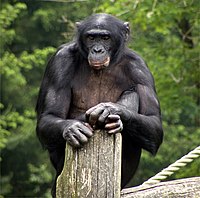
Photo from wikipedia
Meat-type goats and sheep are common small ruminants in the southeast USA, where a vast coverage of woodland (61%) presents a huge potential for supporting small ruminant grazing. However, dense… Click to show full abstract
Meat-type goats and sheep are common small ruminants in the southeast USA, where a vast coverage of woodland (61%) presents a huge potential for supporting small ruminant grazing. However, dense and tall growing plants in woodlands restrict animals’ movement and their access to vegetation. Thus, vegetation growing beyond animals’ reach in woodlands should be managed at low heights for efficient utilization. Studies on how animals would interact with the landscape having different vegetation characteristics is lacking. The objective of the current study was to determine the diurnal behavior and distribution patterns of Kiko wethers (castrated male goats) and Katahdin rams (male sheep) in woodlands with different vegetation heights during fall. Study plots (6 plots, 0.4-ha each) comprised of southern pines, hardwoods, and numerous understory vegetation. The non-target (non-pine) species were either left uncut (control) or cut to one of the heights from the ground level: 0 m, 0.9 m, and 1.5 m. Kiko wethers and Katahdin rams were rotationally stocked in separate plots (3 plots/species) during 2017 and 2018, and their diurnal behavior (dawn–dusk) and distribution patterns monitored when they were in each plot. Animal behavior and distribution data were analyzed in SAS v 9.4, and the distribution evenness index (DEI) in R v 3.4.4. Wethers spent predominant feeding time browsing in areas where non-target plants were cut to 0.9 m and 1.5 m (53–71%), and rams grazed predominantly (49–61%) in areas with non-target plants cut to the ground level, mostly during post-midday ( p < 0.05). Lying was predominant during midday ( p < 0.0001), especially in open spaces ( p < 0.05). Wethers had a higher DEI than rams throughout the study period ( p < 0.01). Vegetation utilization in woodlands was highly influenced by the vegetation height, diurnal period, and study year (age of animals).
Journal Title: Agroforestry Systems
Year Published: 2020
Link to full text (if available)
Share on Social Media: Sign Up to like & get
recommendations!